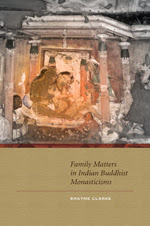Clarke: Family Matters in Indian Buddhist Monasticisms
Clarke, Shayne:
Family Matters in Indian Buddhist Monasticisms / Shayne Clarke. - Honolulu : University of Hawaiʻi Press, 2014 [erschienen: Dezember 2013]. - ca. 296 S.
Hochschulschrift. Teilw. zugl.: Los Angeles, Univ. of California, Diss., 2006 unter dem Titel: Family Matters in Indian Monastic Buddhism
ISBN 978-0-8248-3647-4
US$ 52,00
DDC: 294.36570954
Beschreibung
Scholarly and popular consensus has painted a picture of Indian Buddhist monasticism in which monks and nuns severed all ties with their families when they left home for the religious life. In this view, monks and nuns remained celibate, and those who faltered in their “vows” of monastic celibacy were immediately and irrevocably expelled from the Buddhist Order. This romanticized image is based largely on the ascetic rhetoric of texts such as the Rhinoceros Horn Sutra. Through a study of Indian Buddhist law codes (vinaya), Shayne Clarke dehorns the rhinoceros, revealing that in their own legal narratives, far from renouncing familial ties, Indian Buddhist writers take for granted the fact that monks and nuns would remain in contact with their families.
The vision of the monastic life that emerges from Clarke's close reading of monastic law codes challenges some of our most basic scholarly notions of what it meant to be a Buddhist monk or nun in India around the turn of the Common Era. Not only do we see thick narratives depicting monks and nuns continuing to interact and associate with their families, but some are described as leaving home for the religious life with their children, and some as married monastic couples. Clarke argues that renunciation with or as a family is tightly woven into the very fabric of Indian Buddhist renunciation and monasticisms.
Surveying the still largely uncharted terrain of Indian Buddhist monastic law codes preserved in Sanskrit, Tibetan, and Chinese, Clarke provides a comprehensive, pan-Indian picture of Buddhist monastic attitudes toward family. Whereas scholars have often assumed that monastic Buddhism must be anti-familial, he demonstrates that these assumptions were clearly not shared by the authors/redactors of Indian Buddhist monastic law codes. In challenging us to reconsider some of our most cherished assumptions concerning Indian Buddhist monasticisms, he provides a basis to rethink later forms of Buddhist monasticism such as those found in Central Asia, Kaśmīr, Nepal, and Tibet not in terms of corruption and decline but of continuity and development of a monastic or renunciant ideal that we have yet to understand fully. [Verlagsinformation]
Inhalt
Acknowledgements. ix
Abbreviations. xiii
Conventions. xv
CHAPTER 1: THE RHINOCEROS IN THE ROOM: MONKS AND NUNS AND THEIR FAMILIES. 1
1. Indian Buddhist Monasticism. 2
2. Conflicting Visions of the Ideal Monk. 10
3. Indian Buddhist Monastic Law Codes. 18
4. The Family. 21
5. A Preview of the Inquiry. 27
6. Reading Indian Buddhist Monastic Law Codes. 29
7. A Note on the Scope of the Present Study. 36
CHAPTER 2: FAMILY MATTERS. 37
1. Family Ties Set in Stone. 39
2. From Home to Homelessness. 45
3. Close Shaves with Monkish Assumptions. 56
4. The Family That Eats Together. 58
5. The Family That Stays Together. 62
6. Like Father, Like Son. 63
7. Incidental Incidents and Pugnacious Parents. 68
8. Families on Different Paths. 72
9. Conclusion. 74
CHAPTER 3: FORMER WIVES FROM FORMER LIVES. 78
1. Monastic Education Concerning Sex with One's Wife. 80
2. Monks Arranging a Marriage for Their Children. 87
3. Procedures for Formal Marital Dissolution. 92
4. Relations between Married Monastics. 96
5. A Monastic Family: Udāyin, Guptā, and Their Son, Kumāra-Kāśyapa. 99
6. Mahākāśyapa and His Wife: Ascetic Values in Indian Buddhist Monasticism. 106
7. Married Monastics beyond India. 115
8. Conclusion. 118
CHAPTER 4: NUNS WHO BECOME PREGNANT. 120
1. Mothers Becoming Nuns. 121
2. Nursing Nuns. 124
3. Monastic Motherhood. 129
4. Nuns Becoming Mothers. 134
5. Child Care and Nannying Nuns. 144
6. Conclusion. 146
CHAPTER 5: RECONSIDERING RENUNCIATION: FAMILY-FRIENDLY MONASTICISMS. 150
1. A View of the Evidence. 150
2. Family-Friendly Monasticisms. 152
3. Family-Friendly Monasticism in a Comparative Religious Marketplace. 155
4. A Scholarly Misperception. 162
5. Comparative Monasticism. 163
6. On the Utility of Vinaya Texts for the Study of Indian Buddhist Monasticisms. 165
Notes. 171
Works Consulted. 229
Index of Texts. 263
Index of Authors/Subjects. 267
Autor
SHAYNE CLARKE is associate professor in the Department of Religious Studies at McMaster University. Profile page.
Quellen: University of Hawai'i Press; WorldCat; Bookbutler; Library of Congress; Mitteilung des Verf. in der Mailing-Liste "Indology", 17. Jan. 2014
Bildquelle: University of Hawai'i Press
Bibliography: [1]
References
Ähnlich
- Vinaya Texts
- Bhikkhu-Vibhanga
- Kieffer-Pülz: Verlorene Ganthipadas
- Santuttho: Mahavagga
- Kawanami: Renunciation and Empowerment of Buddhist Nuns
- Die Abhisamācārikā Dharmāḥ
- Handbuch für die buddhistische Mönchsordination
- Therigatha
- Women in Early Indian Buddhism
- Rakow: Transformationen des tibetischen Buddhismus

